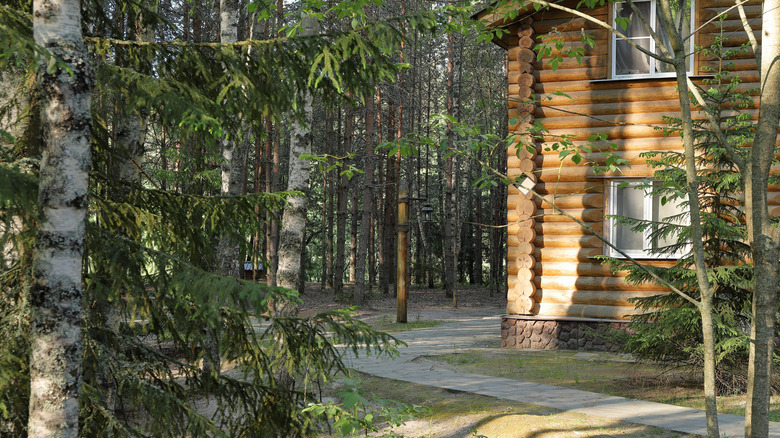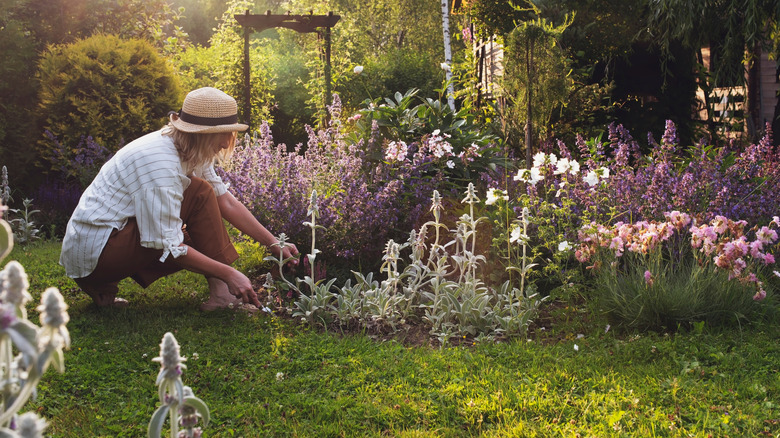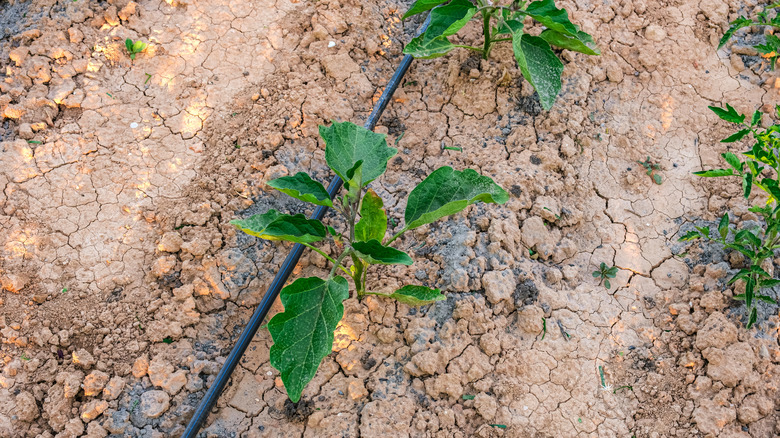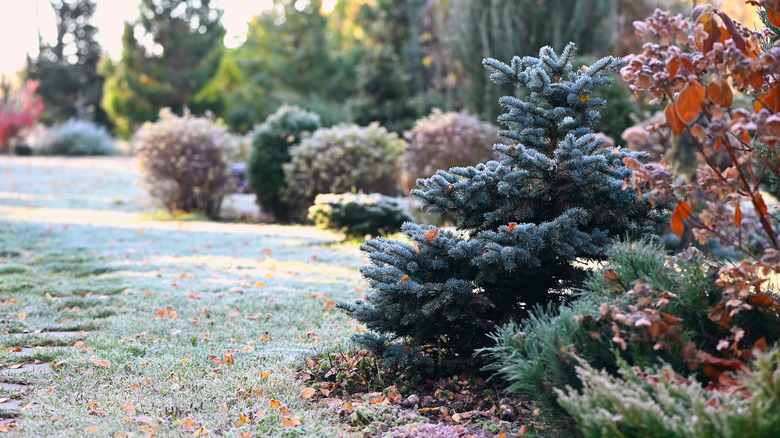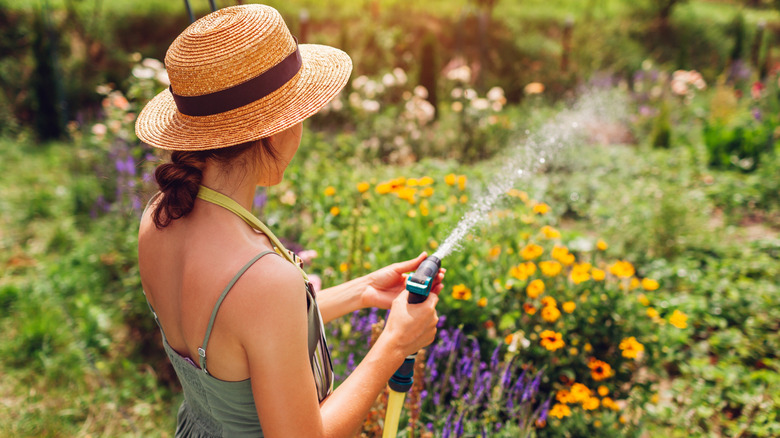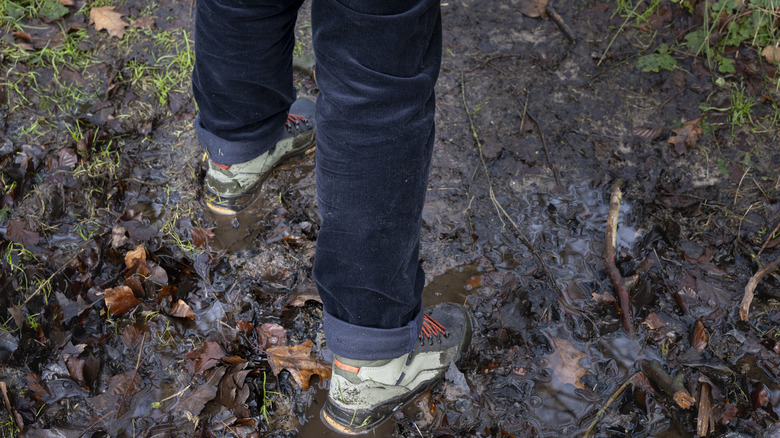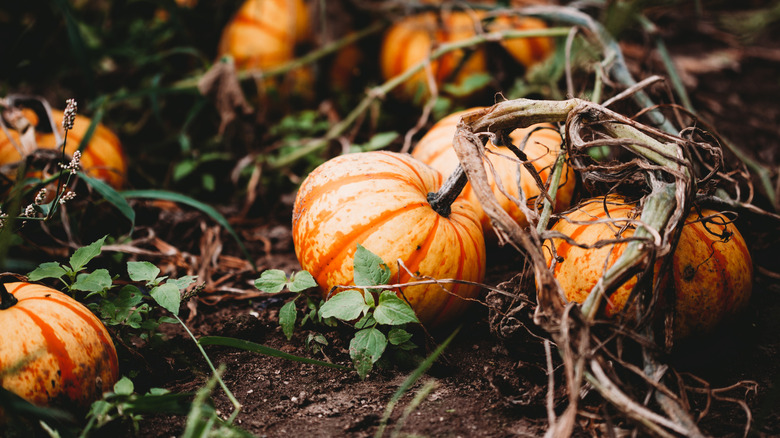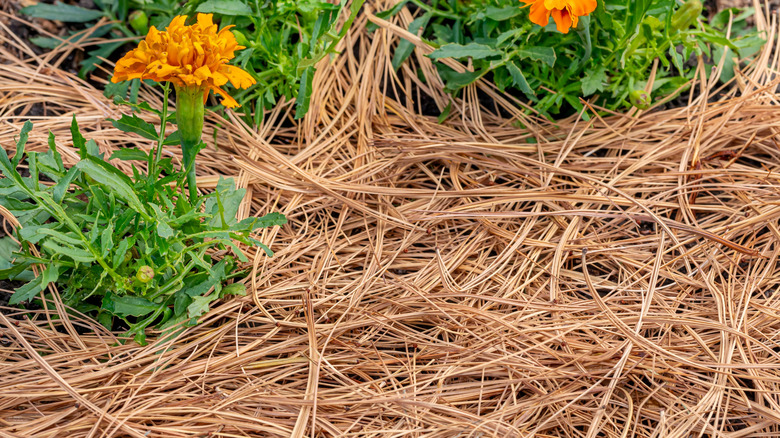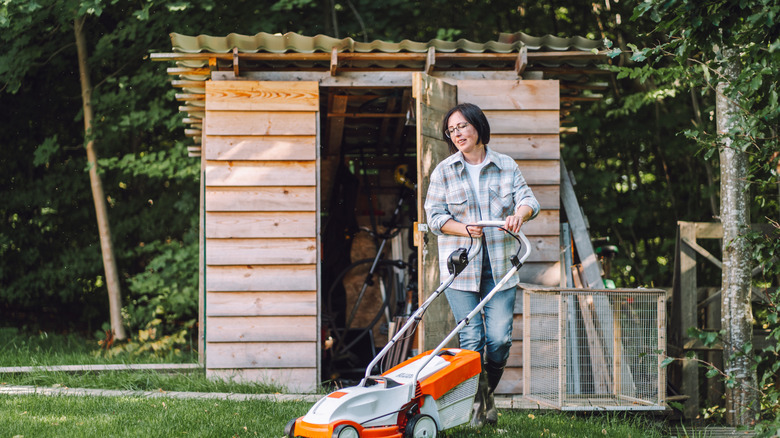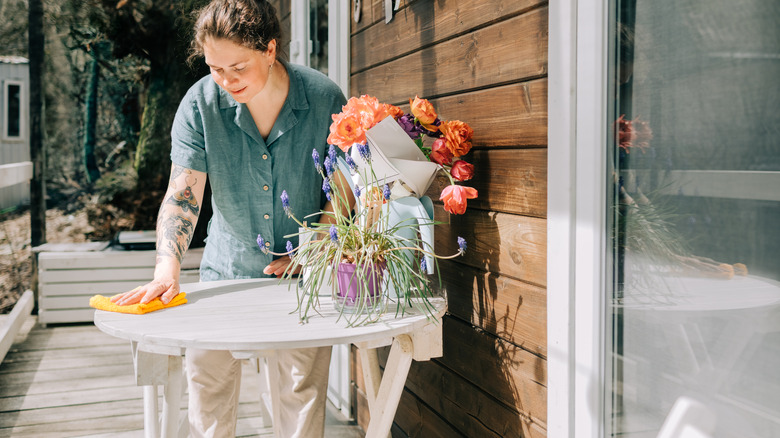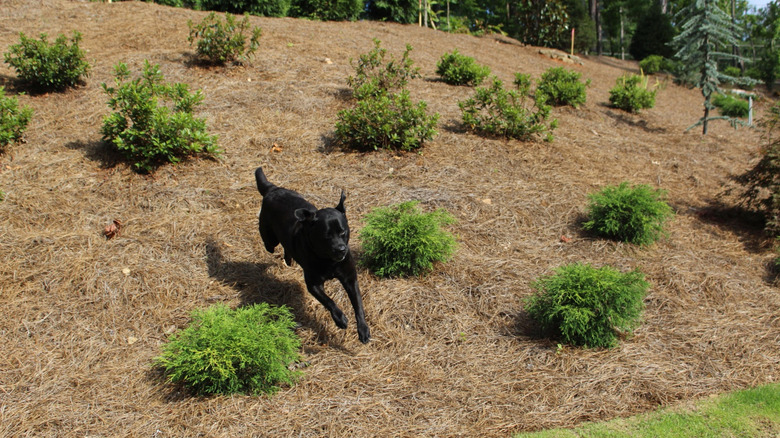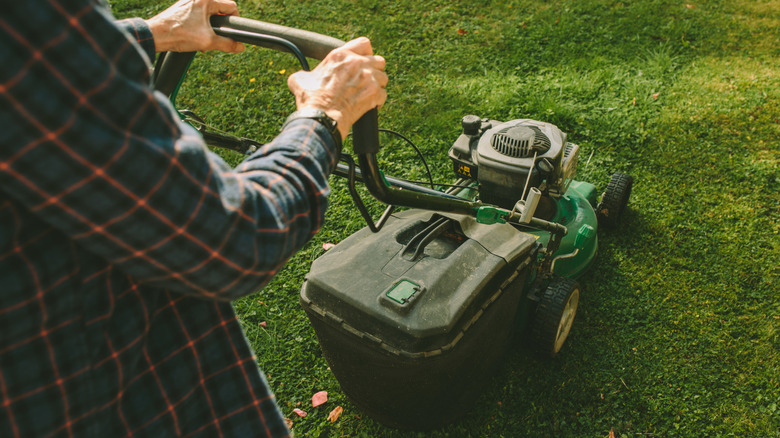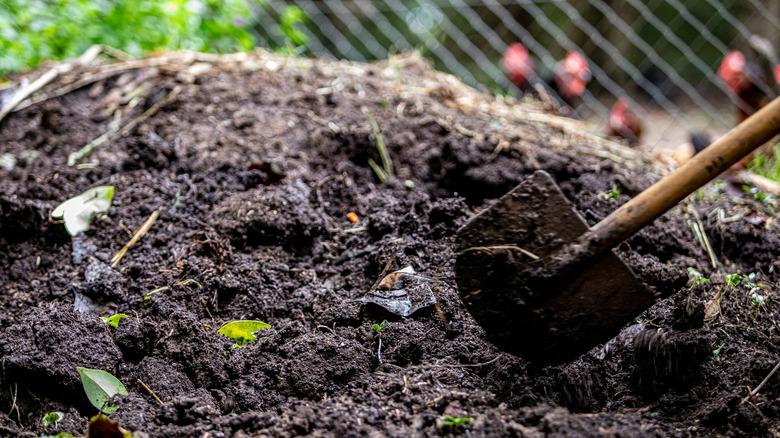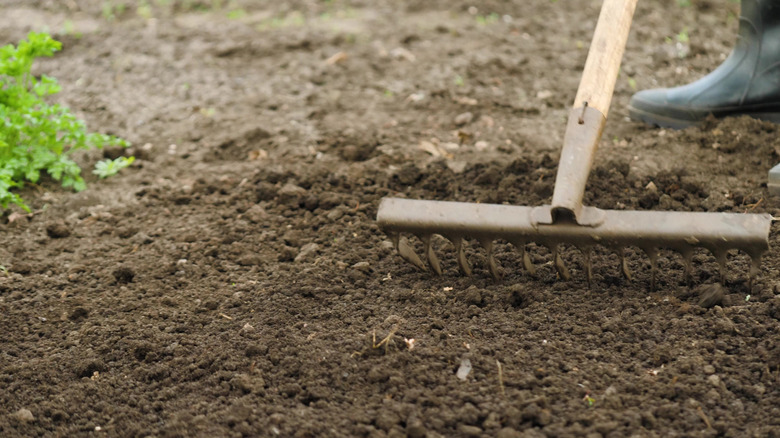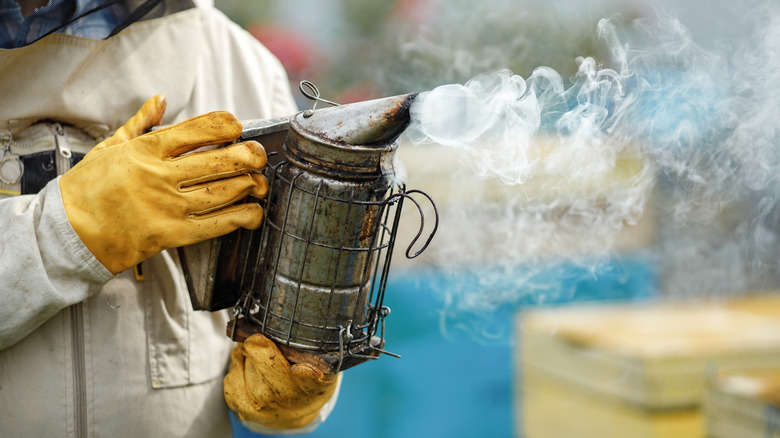When And How To Use Pine Needles In Your Yard And Garden
We may receive a commission on purchases made from links.
Dealing with a plethora of pine needles from your conifer trees? Despite being evergreens, pine trees eventually shed some of their needles — the autumn needle drop is when the tree drops older, yellow or brown needles near the trunk. Those fallen needles might seem like a hassle, but they can work wonders in your yard and garden. Perhaps one of the easiest options is using it as mulch — with so many ways to use mulch in your yard and garden, having a free source of pine needles is a bonus. When used as mulch, the needles help control weeds, retain moisture, and insulate plants from extreme temperatures. They stay in place well and work to cover muddy paths, add a subtle pine scent, add carbon to your compost pile, and serve as fuel for fire pits.
If you don't have pine trees, you can buy bales of pine needle mulch inexpensively. And if you're worried about the acidity of pine needles, the rumors that they make the soil too acidic aren't true. While green pine needles are acidic, the brown, dead needles you use as mulch are relatively neutral because of the breakdown process.
Pine mulch can suffocate weeds
Getting rid of weeds in your garden isn't always easy, but pine mulch can help. A thick enough layer can keep weed seeds from germinating, which can help keep your garden area free of the pesky plants. They do this by blocking the vital sunlight that the weeds need to grow — it helps that they lock together and don't move much, creating a consistent cover that's difficult to penetrate. That means you won't have to deal with pulling weeds as often, and your plants don't face as much competition for the nutrients they need.
Pine needles won't eliminate weeds that are already growing, so you'll want to kill and remove the weeds first before you spread out the needles. Once the weeds are gone, apply 2 to 3 inches of pine needle mulch over the soil where you want to prevent weeds. While pine needle mulch decomposes relatively slowly, it still needs to be refreshed occasionally with a new layer to keep the thickness adequate for weed suppression.
Use pine needles to conserve moisture in the soil
There are some drawbacks to mulching with pine needles, including how flammable they can be, but they also do a good job of retaining moisture for your garden plants. Think of the pine needles as a barrier that locks moisture into the soil instead of letting it evaporate quickly. That's particularly important during hot, dry periods. Adequate mulch can prevent overly dry soil and minimize how often you need to irrigate. Pine needles also do a good job of allowing water to seep through and reach the plants' roots — while they cling together to stay in place, they don't make a thick mat that makes water run off.
To use pine needles to retain soil moisture, lay it over the soil before the weather gets hot and dry — mid to late spring is usually ideal. If you add new plants to your garden at any point, add mulch around them to help retain moisture, especially while they're becoming established. While pine needle mulch is slow to break down, you may need to reapply it if you have an older layer in place.
Add needles during winter to insulate plant roots against the cold
Adding pine needles can keep you from dealing with frost heaving in your winter garden by controlling soil temperatures to minimize freezing and thawing cycles that can push roots out of the ground. In other words, pine mulch, like many types of organic mulch, can serve as a cozy insulator for your perennial plants to help them overwinter successfully. It helps moderate the temperature of the soil during extreme temperature changes. By minimizing exposure of the roots to those temperature fluctuations, you reduce stress on the plant as a whole, which can keep it stronger.
Apply 3 to 4 inches of pine needles in the winter to protect the plants' roots from the cold. The timing is important. If you mulch too early in the fall, it traps moisture in the soil, which can increase the risk of root rot. The ideal time to apply extra winter mulch is once the ground is frozen. That way it stays consistently cold without unexpected soil warming.
When you need to protect plant roots from scorching summer temps
Pine needle mulch also helps protect your plants from extreme heat in the summer. The loose needles help trap pockets of air within the mulch, creating the insulating, protective layer. It helps keep the soil temperature consistent, even if the air temperature increases and decreases. Keeping the soil cooler in extreme heat helps slow water evaporation. The mulch also keeps the plants' roots cooler, which prevents heat injury to the plant tissue and helps minimize plant stress.
Prepare the ground for protection from the heat in the spring while the temperatures are still mild. If you covered the plants with a thick winter mulch layer, remove that in early spring to give the soil a chance to warm up. Keeping a thick layer of mulch in place or adding mulch too early can keep the soil too cold or slow plant development. A 2- to 3-inch layer is sufficient for getting all of the benefits of mulching, including soil temperature control.
Cover muddy paths for walking
Pine needles are a natural garden path solution that keep dirt paths from getting muddy. Adding needles to a path is a low-cost (or even free) solution if you have muddy walkways on your property. They also do a good job of keeping weeds under control on paths. Plus, they're more comfortable to walk on than bumpy gravel.
Use pine needles when you have a natural walkway or path that gets used frequently and is full of worn grass or mud. A layer of at least 3 inches of pine needles helps protect the dirt and create a clean barrier to walk on. It's important to note that pine needles can become slippery underfoot. Avoid using them on slopes where you can easily lose your footing. You might prefer to use pine needles on less-traveled pathways, or use wood pieces or pavers surrounded by pine needle mulch to add more steady footing.
When your chickens need a fresher-smelling bedding, add pine needles
Pines are some of the most fragrant trees that'll make your yard smell better, but the needles can continue making an impact on areas around your home. And if you have a homestead with livestock, one of those areas can be their bedding. Backyard chicken coops and livestock pens can get smelly, but pine needles offer a natural fragrance for those areas. Whether or not the animals mind the odors, a pleasant pine smell makes chore time more pleasant for you.
You won't want to give your chickens, cows, and other animals a full bed of pine needles — they won't absorb the bodily fluids the way bedding needs to. If you use too many pine needles (or similar natural items, like leaves and grass clippings), you might find yourself changing the bedding more often due to the lack of absorbency. Instead, mix the pine needles in with your regular bedding. Aspen and pine shavings are good options to complement the pine needles.
Prevent dirt and moisture from reaching your fresh fruit and veggies
You planned the perfect garden — your strawberries ripen into perfectly sweet morsels in the summer, and fall brings beautiful orange pumpkins throughout the patch. But letting the produce sit on the dirt or dealing with dirt splashing on your harvest can be a pain. In some cases, it can cause crop problems. Strawberries that touch the ground could develop fungal diseases due to the moisture, and they're easily accessible to bugs. Pumpkins that rest directly on damp soil could rot before you harvest them. The same is true for cucumbers and other vining plants.
Covering the soil with a layer of pine needles creates a barrier between the developing fruits and the soil. Lay your mulch around your crops once the soil is warm enough. For example, with pumpkins, wait to mulch until the soil temperature is at least 75 degrees Fahrenheit. On the other hand, you won't want to wait so long that the fruits start to develop before you place the layer of pine needles over the soil.
Needles make effective kindling for a fire
Pine needles are one of many natural materials you can use as kindling in your outdoor fire dish. The dried, dead needles are highly flammable, which makes them a fire risk in certain circumstances. But in your controlled fire pit or burn pile, they offer an effective way to get the fire going.
You can toss dried pine needles into the base of the fire pit as tinder, followed by additional dry materials as kindling for quick flames. Another option is to make little fire starters using the pine needles and paraffin wax. Put cupcake liners in a muffin tray, put pine needles in the cups, and pour melted paraffin wax over them. Adding a cotton or hemp candle wick without metal gives you an easy spot to light the fire starter. Other dry materials, like mini pine cones, dried flowers, and dried herbs, can also go into the melted wax.
Pine mulch is an attractive accent for flower beds
Pine needles offer a consistent look when used as mulch. Unlike many other types of mulch, pine needles don't fade quickly, which means you won't have discolored patches or a lighter look than you want. And they last a long time to maintain a consistent look without constant refreshing. It can be an especially good option if the look you're going for is rustic and natural.
To create the look, layer the pine needles over the soil in your flower garden or landscaped area to a depth of 2 to 3 inches. Leave a gap of about 2 to 3 inches between the pine needle mulch and the base of your trees, flowering shrubs, and other plants to protect the stems and trunks. When choosing pine needles for the job, consider the length and clumping habits of different varieties. The Ponderosa pine offers a long option with needles that grow around 5 to 10 inches long with small clumps of two or three needles. Longleaf pines, as the name suggest, are even longer at up to 14 inches long (or more).
Make pine needle sachets to make your shed smell good
If your yard is full of fresh pine needles, grab them to make pine-scented sachets for your shed, garage, or other storage areas. This is a tidier way to use the pine needles to scent your outdoor areas because it keeps them enclosed in a bag. You can also use a pine needle sachet to make your closet smell fresh and woodsy.
These sachets are simple to make. Jewelry sometimes comes in small organza bags that you can repurpose into your sachet holders, or you can buy empty bags, such as this bulk pack of organza bags from Anznku. Another option is grabbing some fabric and sewing it into simple pouches with pine needles inside. Alternatively, cut the fabric in a circle, place the pine needles in the center, gather the edges, and tie it together with a ribbon to enclose the filling. Natural fiber fabrics are best as they allow the scent to escape well. Add other herbs or dried flowers to complement the pine scent.
Make a natural outdoor cleaning solution
Adding pine needles to water or vinegar creates a solution that you can use to freshen your outdoor surfaces while removing some dirt from them. Vinegar can help kill some germs and clean off gunk like soap scum and mineral buildup (just don't use it on porous surfaces like concrete or stone). The pine needles add to the fragrance of the concoction. You can also boil pine needles with water to create a fragranced liquid ideal for rinsing off outdoor tables or surfaces.
For a simple solution, add enough sprigs of pine to loosely fill a jar. You can also add fresh grated lemon rind or dried citrus peels to the jar. Then, you just need to fill it up with white vinegar, put on the lid, and wait a few weeks while everything melds together. It's a naturally scented vinegar wash that you can use for various surfaces. For many surfaces, you'll want to dilute the mixture with equal parts of water.
Pine mulch sticks to sloped areas better than other mulches
Mulching slopes can be a challenge — many materials move down the slope, resulting in thin spots near the top and thick masses at the bottom. Pine needles combat that issue since they interlock, helping them stay in place on flat surfaces and slopes. They typically aren't displaced by strong winds or rain like other types of mulch are. That makes it a good choice if you live in a rainy climate. Despite being lightweight, they offer a relatively stable mulched surface.
Consider replacing the existing mulch on sloped areas with pine needles, especially if you have difficulty keeping mulch in place or want to focus on reducing soil erosion. The pine needles also help improve the health of any plants that might be growing on the slope. You'll be able to spread them evenly over the slope because they're lightweight and easy to apply. Because the pine needles can be slippery, avoid putting them on sloped areas where you walk regularly.
Mow over fallen pine needles when they're dry
Not sure what to do with all of the fallen pine needles in your lawn? Your pine tree is a free source of mulch, but you may end up with more needles than you need for other areas of your lawn. Many homeowners treat the pine needles as they would regular leaves from deciduous trees, moving over them to chop them up. While you might not want to leave all of the pine needle pieces on your lawn, some can put nutrients back in the soil, and others can be used for other purposes.
Grab your mower when the majority of the needle fall has happened for the year. Go over the needle-covered areas with your mower to chop them into small pieces. The smaller needles can go into your veggie and fruit garden for a softer ground cover with less risk of getting poked when you collect your harvest. Leave some of the pine needle pieces in your lawn, as they'll add nutrients as they decompose.
Add to your compost pile when it needs more carbon
Can you add pine needles to your compost pile? Yes, you can, and the dried needles add necessary carbon to the pile. They also help with airflow within the pile since they don't become compacted. Oxygen helps support all of the beneficial microbial activity that takes place in a compost pile. The pine needles won't make your finished compost acidic since the composting process neutralizes them.
Since pine needles are so slow to decompose, limit how much you add to your compost pile — make the needles no more than 10% of the content. Add plenty of materials that decompose quickly to balance out the pine needles. Green, nitrogen-rich compost materials can be helpful to balance out the carbon in your pine needles. Shredding or chopping the pine needles before putting them in the compost pile may also help them break down faster. And, finally, using the pine needles as mulch first and then moving them to the compost bin can help them decompose quickly.
Dig pine needles into your soil when you need increased aeration
Just like pine needles hold space for oxygen in a compost pile, they can do the same in your garden or lawn soil. Working pine needles or other organic matter into the soil can increase the flow of oxygen through the soil and improve drainage, which helps protect the roots of your plants. And, since the decomposition of pine needles is relatively slow, the aeration benefits last for multiple seasons.
If pine needles naturally fall on your garden area, you can simply work them into the soil. Or, add a small amount of pine needles in an area that needs better drainage and aeration. To improve aeration in compacted soil, mix a modest amount of dried pine needles into the top 4 to 6 inches using a cultivator. They'll help loosen the soil and enhance drainage, but for planting holes, it's best to rely on compost or fine mulch rather than pine needles.
When you keep bees and need fuel for your bee smoker
Estimates show that upwards of 115,000 to 125,000 people keep bees in the U.S. And, while some of those are commercial beekeepers, many of those people are hobbyists dabbling in beekeeping with just a few hives. If you're included in those numbers, you're likely familiar with bee smokers — they're helpful in reducing stings while inspecting hives and they minimize the defensive actions of the insects. The fuel choice for the smoker is essential. It can't contain harmful chemicals, and it needs to create cool, thick, gentle smoke for effectiveness. If you use a bee smoker, consider pine needles as a fuel source. The flammability of the needles helps them light easily, and they create dense smoke.
To use pine needles in your smoker, start by lighting a small bunch of pine needles or newspaper for the bottom. Then, add a little more at a time until you fill the smoker, and close the top. Layering dry needles with fresh needles can help create a cooler smoke and a fire that doesn't burn too quickly. Pine needles can cause a buildup of resin in the smoker, so you'll need to clean it out occasionally.
